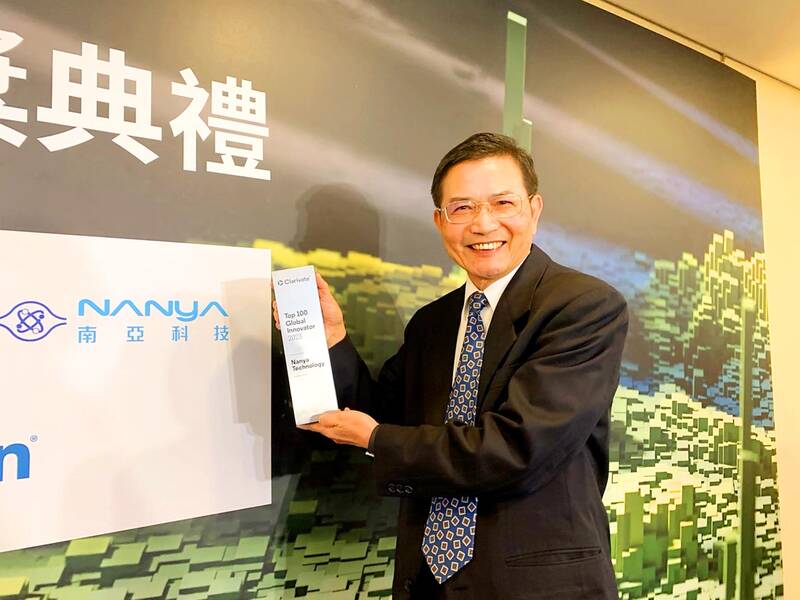DRAM chipmaker Nanya Technology Corp (南亞科技) yesterday reported a widening quarterly loss of NT$1.69 billion (US$55.5 million) for last quarter as lower chip prices and idled equipment depreciation costs drove gross margin into negative territory for the first time in about a decade.
That was compared with a loss of NT$1.15 billion in the fourth quarter last year. The New Taipei City-based chipmaker reported net profit of NT$6.55 billion during the first quarter of last year.
Average selling prices and shipments fell at high-single-digit percentages last quarter on a quarterly basis, as demand weakened for all applications from mobile phones, computers and servers, to consumer electronics.

Photo: Grace Hung, Taipei Times
People have been unwilling to spend on lavish electronics, while businesses have tightened capital budgets amid a weak world economy, geopolitical turmoil in Europe, high inflation, and recent bank crises in the US and Europe, the chipmaker said.
Nanya Technology lowered output by about 20 percent to cope with the weakness.
Gross margin sank to minus 8.6 percent last quarter, from 13 percent in the previous quarter and 43.9 percent in the first quarter of last year, the company said in a statement.
“If the company did not cut output, gross margin would have been in the positive territory,” Nanya Technology president Lee Pei-ing (李培瑛) told a virtual media briefing.
Idled equipment costs led to an increase in unit costs, as shipments dropped, the company said.
As demand remains weak, Nanya Technology plans to extend the 20 percent reduction rate into this quarter.
The company expects average selling prices to fall slightly this quarter as the world’s major memorychip makers are likely to work through excess inventory as a result of output reductions.
Samsung Electronics Co’s announcement on Friday that it would lower production to a “meaningful level,” helped boost Nanya Technology’s stock price, which rallied 2.25 percent to NT$68.2 yesterday.
“There is the possibility that pricing would bottom out this quarter,” Lee said, adding that he still maintains that DRAM prices would stabilize in the third quarter.
An improvement in supply-and-demand dynamics might help bring back Nanya Technology’s gross margin into positive territory late this quarter or next quarter, he said, adding that the company expects to have a clearer picture in the next one to two months.
Overall, output adjustments by DRAM suppliers in the first half of this year along with seasonal demand might help reduce inventories and contribute to marginal DRAM market recovery in the second half, he said.
The penetration of artificial intelligence and 5G-related technology might help improve server DRAM demand, while mobile DRAM might pick up in the second half of this year, benefiting from seasonal demand related to smartphone shipments, particularly in China, he said.
PC DRAM demand might increase mostly due to lower inventory and increases in average DRAM content in computers, he said.
DRAM used in consumer electronics might recover in the second half as demand for Internet protocol cameras, networking devices, and industrial and automotive applications remain relatively healthy, he said.

MULTIFACETED: A task force has analyzed possible scenarios and created responses to assist domestic industries in dealing with US tariffs, the economics minister said The Executive Yuan is tomorrow to announce countermeasures to US President Donald Trump’s planned reciprocal tariffs, although the details of the plan would not be made public until Monday next week, Minister of Economic Affairs J.W. Kuo (郭智輝) said yesterday. The Cabinet established an economic and trade task force in November last year to deal with US trade and tariff related issues, Kuo told reporters outside the legislature in Taipei. The task force has been analyzing and evaluating all kinds of scenarios to identify suitable responses and determine how best to assist domestic industries in managing the effects of Trump’s tariffs, he

TIGHT-LIPPED: UMC said it had no merger plans at the moment, after Nikkei Asia reported that the firm and GlobalFoundries were considering restarting merger talks United Microelectronics Corp (UMC, 聯電), the world’s No. 4 contract chipmaker, yesterday launched a new US$5 billion 12-inch chip factory in Singapore as part of its latest effort to diversify its manufacturing footprint amid growing geopolitical risks. The new factory, adjacent to UMC’s existing Singapore fab in the Pasir Res Wafer Fab Park, is scheduled to enter volume production next year, utilizing mature 22-nanometer and 28-nanometer process technologies, UMC said in a statement. The company plans to invest US$5 billion during the first phase of the new fab, which would have an installed capacity of 30,000 12-inch wafers per month, it said. The

Taiwan’s official purchasing managers’ index (PMI) last month rose 0.2 percentage points to 54.2, in a second consecutive month of expansion, thanks to front-loading demand intended to avoid potential US tariff hikes, the Chung-Hua Institution for Economic Research (CIER, 中華經濟研究院) said yesterday. While short-term demand appeared robust, uncertainties rose due to US President Donald Trump’s unpredictable trade policy, CIER president Lien Hsien-ming (連賢明) told a news conference in Taipei. Taiwan’s economy this year would be characterized by high-level fluctuations and the volatility would be wilder than most expect, Lien said Demand for electronics, particularly semiconductors, continues to benefit from US technology giants’ effort

‘SWASTICAR’: Tesla CEO Elon Musk’s close association with Donald Trump has prompted opponents to brand him a ‘Nazi’ and resulted in a dramatic drop in sales Demonstrators descended on Tesla Inc dealerships across the US, and in Europe and Canada on Saturday to protest company chief Elon Musk, who has amassed extraordinary power as a top adviser to US President Donald Trump. Waving signs with messages such as “Musk is stealing our money” and “Reclaim our country,” the protests largely took place peacefully following fiery episodes of vandalism on Tesla vehicles, dealerships and other facilities in recent weeks that US officials have denounced as terrorism. Hundreds rallied on Saturday outside the Tesla dealership in Manhattan. Some blasted Musk, the world’s richest man, while others demanded the shuttering of his